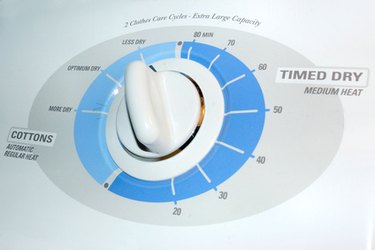
According to the Consumer Product Safety Commission website, overheated clothes dryers are a common cause of fires in homes. One of the causes of this overheating is excessive lint buildup in the dryer exhaust vents. As lint accumulates, it allows for less heat and moisture to be expelled, resulting in overheating. The longer your vents are, the more likely they are to become clogged with lint and debris because of a loss of air pressure to push it out of the vent. The way your vent is installed can make the maximum safe length fluctuate considerably.
Straight Flexible
Video of the Day
Dryer vent hoses that are run in a straight line from the dryer exhaust to the outdoors provide the best ventilation and reduce the likelihood of trapped lint. When using a straight piece of flexible metal vent hose, the maximum length allowed for safe ventilation is approximately 30 feet, according to the Appliance Aid website. While the lint should escape and prevent overheating at this length, it is preferable to go with a shorter length if the arrangement of your appliances will allow for it. Flexible vinyl vent hoses were once common, but they are not recommended today because of the increased likelihood of fires associated with them. They should never be used on a gas dryer.
Video of the Day
Straight Rigid
Straight metal vent ducts are the best possible material used to vent your dryer. Sections should be fitted together without using screws that protrude into the air's path, which could act as obstructions for lint to begin gathering on. If you use a smooth, rigid metal vent you may run it as much as 43 feet from the dryer exhaust to the outside. Again, this is the maximum, and attempts should be made to use as short of a distance as possible.
Vent Size
If you will use the maximum length allowances, ensure you are using the appropriate size vent hose to do the job. You should not use any venting that is less than 4 inches in diameter, according to the Great Inspector website. Vents narrower than 4 inches across drastically reduce the ability to expel heat and moisture from the machine.
With Fabric Softener
If you plan to use fabric softener sheets in your dryer, they will reduce the safe length of your dryer vents. This common method of keeping clothes soft and static free also adds to the buildup potential of each load. If your vents will be more than 3 feet in length, you should not use this type of fabric softener, according to the Great Inspector website.
With Vent Hoods
Your vent hood mounted on the outside of the home affects the length at which your dryer vents can operate safely. If you are using a vent hood with at least a 4-inch opening, your maximum length does not change. But if you are using a louvered vent hood, it decreases the maximum safe length by about 2 feet. A narrow 2.5-inch opening in a hood reduces the maximum length by around 6 feet.
Bends
Every bend in the vent hose reduces the air pressure and the ability to expel lint and moisture. As a general rule, you should reduce the maximum vent length by 2.5 feet for every 90-degree turn in the vent hose.